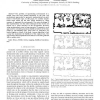Free Online Productivity Tools
i2Speak
i2Symbol
i2OCR
iTex2Img
iWeb2Print
iWeb2Shot
i2Type
iPdf2Split
iPdf2Merge
i2Bopomofo
i2Arabic
i2Style
i2Image
i2PDF
iLatex2Rtf
Sci2ools
139
Voted
RAS
2010
2010
Maximum-likelihood sample-based maps for mobile robots
— The problem of representing environments of a mobile robot has been studied intensively in the past. The predominant approaches for geometric representations are gridbased or line-based maps. In this paper, we consider samplebased maps which use the data points obtained by range scanners to represent the environment. The main advantage of this representation over the other techniques is that it does not impose any a priori structure on the environment. However, range measurements come in large amounts. We present a novel approach for calculating maximum-likelihood subsets of the data points by sub-sampling laser range data. In particular, our method applies a variant of the fuzzy k-means algorithm to find a map that maximizes the likelihood of the original data. Our approach has been implemented and tested on real data gathered with a mobile robot.
| Added | 30 Jan 2011 |
| Updated | 30 Jan 2011 |
| Type | Journal |
| Year | 2010 |
| Where | RAS |
| Authors | Daniel Meyer-Delius, Wolfram Burgard |
Comments (0)

